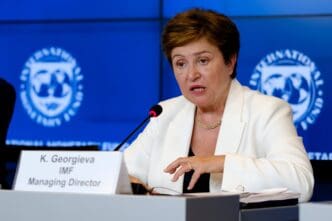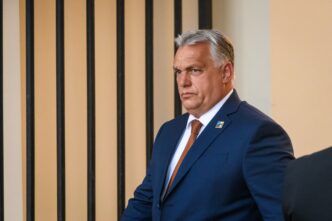Executive Summary
The Story So Far
Why This Matters
Who Thinks What?
Global finance leaders gathering in Washington this week for the annual meetings of the International Monetary Fund (IMF) and World Bank are set to confront renewed U.S.-China trade tensions following President Trump’s threats of escalating tariffs. The discussions, involving finance ministers and central bankers from over 190 countries, shifted focus after President Trump vowed “100% duties” on Chinese imports and China responded with expanded rare earth export controls and new port levies, casting a shadow over recent efforts to de-escalate trade hostilities.
Escalating Trade Tensions Dominate Agenda
The sudden escalation on Friday shattered a delicate five-month truce between Washington and Beijing that had seen tariffs reduced and contributed to upgrades in the IMF’s global growth outlook. President Trump’s threat to cancel a planned meeting with Chinese President Xi Jinping and impose a “massive increase” in tariffs triggered a significant U.S. stock sell-off, intensifying global market anxiety.
China’s retaliatory measures included matching new U.S. port fees for Chinese-built or owned vessels with its own levies on ships built or flagged in the U.S. or owned by companies with substantial U.S. investment. These developments are now expected to dominate the proceedings, bringing volatility to the discussions.
Martin Muehleisen, formerly a chief strategist at the IMF and now with the Atlantic Council, suggested President Trump’s threats might be a negotiating tactic, but warned of significant market pain if 100% tariffs are reinstated. While China holds leverage through its dominance in rare earths, critical for tech manufacturing, Muehleisen noted it is not in Beijing’s interest to return to an environment of triple-digit tariffs.
Global Economic Resilience and Forecasts
Prior to the latest trade escalation, IMF Managing Director Kristalina Georgieva had highlighted the global economy’s surprising resilience against various shocks, including tariff costs, a slowing U.S. job market, rising debt, and the rapid adoption of artificial intelligence. Georgieva projected that the global GDP growth rate for 2025 would be only slightly less than the 3.3% recorded for 2024.
The IMF had previously raised its 2025 GDP growth forecast to 3.0% in July, based on lower-than-anticipated tariff rates. Georgieva cautioned, however, that while there is demonstrable resilience, the global economy faces exceptional uncertainty with downside risks still dominating the forecast.
G7 Focus on Russia and Ukraine Aid
Beyond trade, finance ministers from the Group of Seven (G7) industrial democracies are scheduled to meet to discuss intensifying sanctions pressure on Russia. The aim is to curtail Moscow’s energy revenues and restrict its access to overseas assets, in compliance with international law, as part of efforts to end the conflict in Ukraine.
Among the options under consideration is a European Union proposal to utilize frozen Russian sovereign assets to back a 140 billion euro ($162 billion) loan for Ukraine. This initiative underscores the ongoing international commitment to supporting Ukraine and imposing economic costs on Russia.
U.S. Treasury’s Agenda and Institutional Roles
The U.S. Treasury’s influence at the meetings extends to calls for the IMF and World Bank to re-focus on their core missions of financial stability and development, potentially scaling back on climate and gender issues. U.S. Treasury Secretary Scott Bessent’s agenda also advocates for stronger IMF criticism of China’s state-led economic policies.
The meetings mark the public debut of Dan Katz, the IMF’s new No. 2 official, who previously served as Bessent’s chief of staff. Member countries will closely observe how Katz navigates the U.S. Treasury chief’s priorities.
The U.S. Treasury’s recent market intervention on behalf of Argentina, the IMF’s largest borrower, will also be a key topic. Argentine President Javier Milei is expected to meet with President Trump at the White House, further highlighting the geopolitical dimensions of financial aid.
Muehleisen expressed concern that the IMF, as its largest shareholder, might be pressured by the U.S. to advance its geopolitical objectives, potentially increasing pressure on China and extending aid to allies without adequate reforms. This raises questions about the organization’s multilateral nature versus its potential role as an “appendage of the U.S. Treasury.”
Outlook for Global Finance Leaders
As global finance chiefs convene, the immediate challenge lies in navigating the renewed U.S.-China trade tensions and their potential impact on global economic stability. Alongside these critical trade discussions, leaders will address ongoing efforts to sanction Russia, support Ukraine, and debate the strategic direction and core missions of key international financial institutions in an increasingly complex geopolitical landscape.








